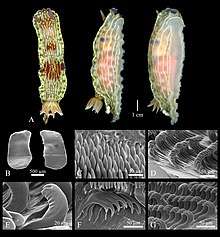Felimare bayeri
Felimare bayeri is a species of colorful sea slug or dorid nudibranch, a marine gastropod mollusk in the family Chromodorididae. It was described by Eveline and Ernst Marcus in 1967.[1]
| Felimare bayeri | |
|---|---|
 | |
| Felimare bayeri | |
| Scientific classification | |
| Kingdom: | Animalia |
| Phylum: | Mollusca |
| Class: | Gastropoda |
| Subclass: | Heterobranchia |
| Order: | Nudibranchia |
| Suborder: | Doridina |
| Superfamily: | Doridoidea |
| Family: | Chromodorididae |
| Genus: | Felimare |
| Species: | F. bayeri |
| Binomial name | |
| Felimare bayeri Ev. Marcus & Er. Marcus, 1967[1] | |
| Synonyms[2] | |
| |
Taxonomic history
Originally described as the only member of the new genus Felimare, it was subsequently transferred to Hypselodoris and Felimare was considered to be a synonym.[3] However, in 2012 a thorough re-evaluation of the genera in the family Chromodorididae based on molecular data, DNA sequences, revealed several distinct clades and Felimare was resurrected for one of these.[4] Felimare is currently considered to be the genus to which all Atlantic Ocean Hypselodoris species belong including all the blue and yellow-striped species from the Caribbean and the Mediterranean Sea.
Distribution
This nudibranch is found in the Caribbean Sea[5] (Florida, Belize, Mexico, Panama and Cuba) and the Gulf of Mexico.[3][6][7]
Description

Dark blue in color with a series of yellow longitudinal lines, it exhibits purple-blue rhinophores and opaque white branchial leaves marked by dark rachises.[3] The foot's posterior end is blue with black spots and yellow lines.[3] The maximum recorded length is 60 mm.[8] The original description of the colour pattern reads "The color alive (based on a photograph) is: notum blue with 6-10 longitudinal anastomosing orange yellow lines edged with black, the more lateral ones often interrupted. The margin of the notum is white, indistinctly set off from the blue ground color, containing black spots of different size, and bordered by a yellow line externally. There is a yellow circle around the blue rhinophores. The gills are colorless with a black line alone the afferent vessel and a yellow with black one along the efferent vessel. The tail is white with orange yellow lines and black spots, edged with blue. The sides of the foot bear yellow stripes."[9][10]
Ecology
This species feeds on a blue species of the sponge Dysidea.[5] It has been found at depths from 3 m[8] to at least 18 m and possibly 70 m.[5]
References
- Marcus, Ev. & Marcus, Er. "American Opisthobranch Mollusks." Studies in Tropical Oceanography 6:1967 pp. 62-64, figs. 76-79, pl. 1, fig. 2.
- Bouchet, P.; Caballer, M. (2012). Felimare bayeri. Accessed through: World Register of Marine Species on 2012-05-11
- Valdés, Ángel; Hamann, Jeff; Behrens, David W.; DuPont, Anne. Caribbean Sea Slugs, Sea Challengers Natural History Books, Etc., Gig Harbor, Washington 2006, pp. 158-159. ISBN 0-9700574-2-3
- Johnson R.F. & Gosliner T.M. (2012) Traditional taxonomic groupings mask evolutionary history: A molecular phylogeny and new classification of the chromodorid nudibranchs. PLoS ONE 7(4): e33479
- Rudman, W.B., 2005 (February 2) Hypselodoris bayeri (Marcus & Marcus, 1967). [In] Sea Slug Forum. Australian Museum, Sydney.
- Ortea, J., Valdés, Á. & García-Gómez, J.C. (1996). Revisión de las especies atlánticas de la familia Chromodorididae (Mollusca: Nudibranchia) del grupo cromático azul. Avicennia suplemento 1: 1-165 page(s): 84
- Rosenberg, G., F. Moretzsohn, and E. F. García. 2009. Gastropoda (Mollusca) of the Gulf of Mexico, Pp. 579–699 in Felder, D.L. and D.K. Camp (eds.), Gulf of Mexico–Origins, Waters, and Biota. Biodiversity. Texas A&M Press, College Station, Texas.
- Welch J. J. (2010). "The "Island Rule" and Deep-Sea Gastropods: Re-Examining the Evidence". PLoS ONE 5(1): e8776. doi:10.1371/journal.pone.0008776.
- Rudman W.B. (1984) The Chromodorididae (Opisthobranchia: Mollusca) of the Indo-West Pacific: a review of the genera. Zoological Journal of the Linnean Society 81 (2/3): 115-273. page(s): 188
- Debelius, H. & Kuiter, R.H. (2007) Nudibranchs of the world. ConchBooks, Frankfurt, 360 pp. ISBN 978-3-939767-06-0 page(s): 108
| Wikimedia Commons has media related to Felimare bayeri. |